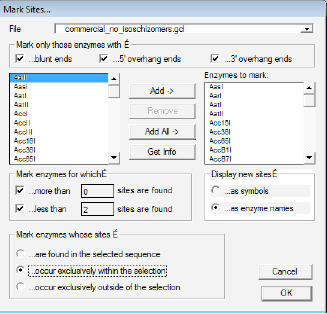

- DARTMOUTH COMPUTER GENE CONSTRUCTION KIT FULL
- DARTMOUTH COMPUTER GENE CONSTRUCTION KIT SOFTWARE
- DARTMOUTH COMPUTER GENE CONSTRUCTION KIT PROFESSIONAL
A decrease in concentration in the following order of proteins can be deduced from the graph: Cdc2, Cdc13, Cig2, Cdc10, Cdc25, and Wih5.

The point at which the cell begins its cell cycle, shows maximum fluorescence, and undergoes nuclear division were measured and averaged to be graphed on Excel.
DARTMOUTH COMPUTER GENE CONSTRUCTION KIT FULL
Two full cell cycles completed over the duration of approximately four hours were modelled. Data was obtained through live cell imaging on the Onix2 system and subsequently graphed on Python.įig 3. The Cdc2-Cdc13 MPF complex controls the progression through the different stages of a cell cycle, while Cdc25 dephosphorylates and thereby activates MPF at late G2 phase to promote entrance into the M phase. The red markers indicate the point of nuclear division at the end of mitosis. Time-dependent oscillations in the concentration of proteins involved in a S.pombe’s cell cycle were graphed.

pombe through a mathematical model with numerically quantified parameters.įig 2. This will enable the representation of the molecular mechanisms involved in the cell cycle of S. The research can be further developed by attaining additional measurements such as protein synthesis and dissociation rates which are involved in an ordinary differential equation that models the S. This allowed deductions to be made on the roles and properties of individual proteins in regulating the cell cycle.
DARTMOUTH COMPUTER GENE CONSTRUCTION KIT SOFTWARE
The resulting data obtained was quantified using the ImageJ software and graphed to present the time-specific changes in protein concentrations. mNeonGreen localized at the nucleus for cdc13, cdc2, and cdc25, while localization at the cytoplasm was observed for the reference gene, adh15. Changes in the expression level of fluorescence-tagged genes throughout the progression of cell cycle were examined. This enabled me to visualize the expression patterns of genes such as cdc25 that fluoresce at much lower intensities.įig 1. Moreover, I examined the expression of genes tagged with mNeonGreen, a fluorescence marker that is known to be up to five times brighter than GFP. Confocal fluorescence imaging was subsequently conducted to examine the oscillations in fluorescence intensity over the duration of 16 hours. To examine such properties, I first integrated GFP, a green fluorescence protein, at the 3’ end of a chromosomal open reading frame so that the resulting gene construct will fluoresce in varying intensities depending on the protein concentration. The progression of biochemical events from G1 to M phase in its cell cycle is known to be regulated through a single CDK-cyclin complex composed of Cdc2 and Cdc13, alongside the activation of additional protein substrates at distinct timepoints. My research primarily focused on examining the proteins involved in controlling the cell cycle of Schizosaccharmyces pombe, otherwise known as fission yeast. Throughout the course of the next month and a half, I was able to get a deep insight on using advanced techniques and equipment to visualize and model various intracellular mechanisms. Among the other host labs, Professor Aoki lab’s unique approach in presenting scientific results through microscopy visualizations and precisely quantified data appealed to me as an opportunity to obtain skills in both practical research and scientific communication.
DARTMOUTH COMPUTER GENE CONSTRUCTION KIT PROFESSIONAL
Although I had limited experience in conducting experiments at a professional laboratory, I was motivated to intern at Professor Aoki’s laboratory specializing in quantitative biology upon reading one of his publications. I immersed myself in the NIBB internship program as an undergraduate student who had just completed her first year of Medical Biosciences degree at Imperial College London.


 0 kommentar(er)
0 kommentar(er)
